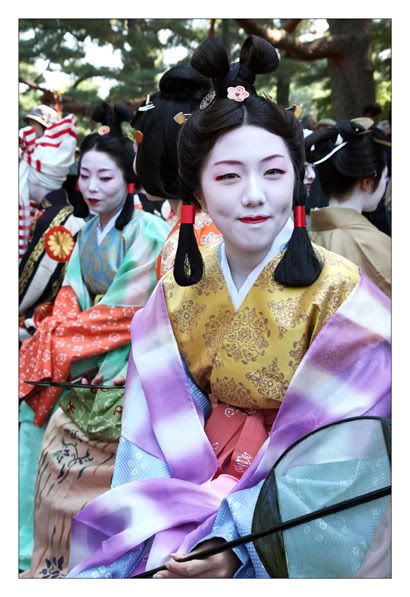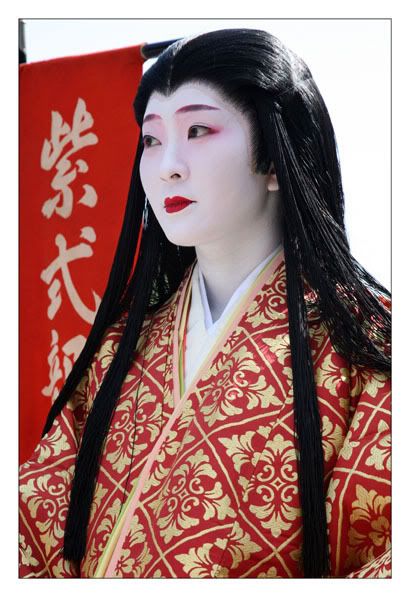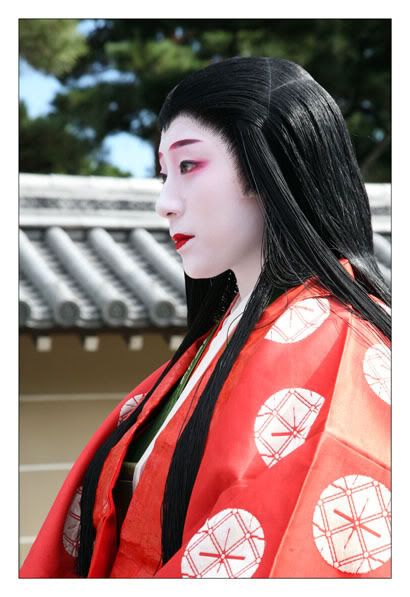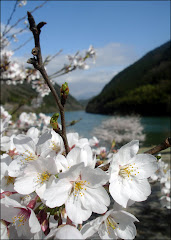
Early Heian Era court style, still heavily influenced by China.
Desperate to separate his court from the growing politcal power of the Buddhist temples of Nara, Emperor Kammu fianlly chose idyllic Yamashiro, surrounded by mountains and blessed with clear water, as the location of his new capital, Heian-Kyo: the Capital of Peaceful Tranquility. Known today as Kyoto, it remained the nation's capital until 1867. Jidai Matsuri, or the Festival of Ages, commemorates his decision, made over 1,200 years ago (October 22, 794).
Desperate to separate his court from the growing politcal power of the Buddhist temples of Nara, Emperor Kammu fianlly chose idyllic Yamashiro, surrounded by mountains and blessed with clear water, as the location of his new capital, Heian-Kyo: the Capital of Peaceful Tranquility. Known today as Kyoto, it remained the nation's capital until 1867. Jidai Matsuri, or the Festival of Ages, commemorates his decision, made over 1,200 years ago (October 22, 794).
 Kudara O Myoshin, the wife of a powerful government minister, gained the trust of Emperor Kanmu who honored her with the position of Chief Lady-in-Waiting at the Imperial Court.
Kudara O Myoshin, the wife of a powerful government minister, gained the trust of Emperor Kanmu who honored her with the position of Chief Lady-in-Waiting at the Imperial Court.The Heian Imperial court enjoyed a relatively long period of peace and prosperity lasting nearly 400 years, until 1185. The most influential clan of the era was the aristocratic Fujiwara family who succeeded in dominating the royal family by marrying their daughters to emperors and ruling on behalf of their offspring when they assumed the throne. The Fujiwara controlled politics and cultivated the cultural scene, encouraging an aura of courtly sophistication and sensitivity in all of their activities, including the visual and literary arts and religious practice. This refined sensibility and aesthetic interest is clearly expressed in the literary classic The Tale of Genji, written by a member of the Fujiwara clan known to us today as Murasaki Shikibu.

Kimina, geiko of Miyagawa-cho, as Murasaki Shikibu, Heian Era courtier and author of "The Tale of Genji".
After centuries of absorbing and adopting the culture of the continent, the Japanese began to experience a growing sense of self-confidence and appreciation of their own heritage. Although trade expeditions and Buddhist pilgrims continued to travel between Japan and the continent, the court terminated official relations with China. One of the most important developments of this time was the Japanese syllabic kana script, which led to the cultivation of waka poetry and other distinctive literary forms, such as narrative tales (monogatari) and diaries (nikki).

Kikuno, geiko of Miyagawa-cho as Sei Shonagon, contemporary and rival of Murasaki Shikibu and author of Makura no Soshi, "The Pillow Book".

Kikuno, geiko of Miyagawa-cho as Sei Shonagon, contemporary and rival of Murasaki Shikibu and author of Makura no Soshi, "The Pillow Book".




1 comment:
OOO! I LOVE THESE PICTURES!
They really bring a face to the story that you're telling. :)
Also helped me piece together the influence of China on Japan in the Heian period for my English Paper!
:)
Post a Comment